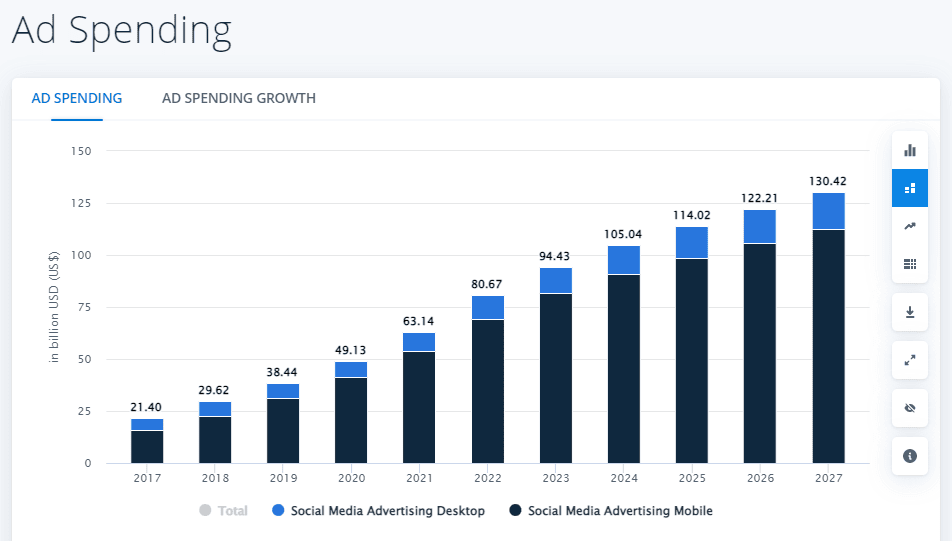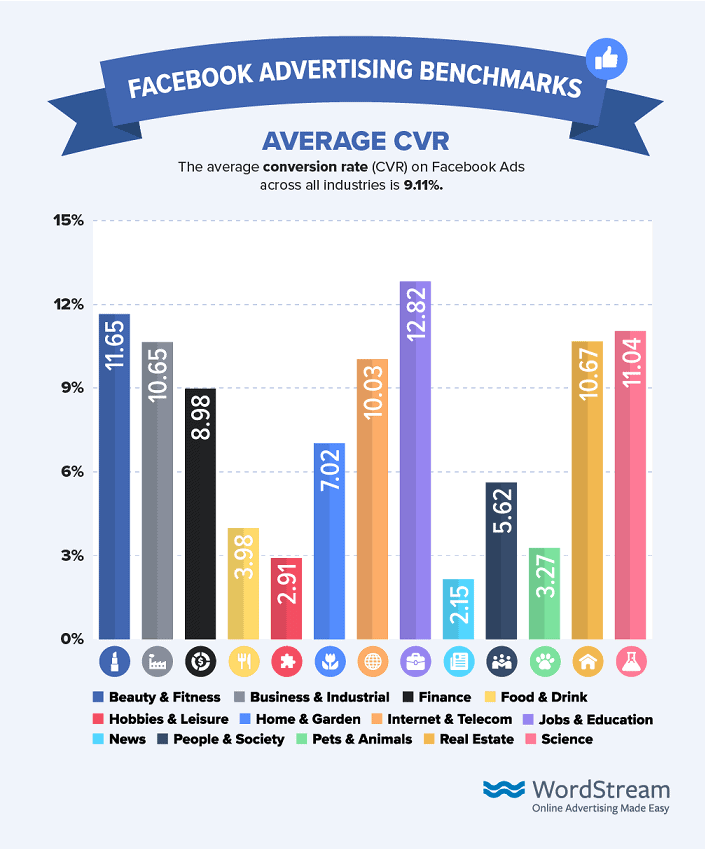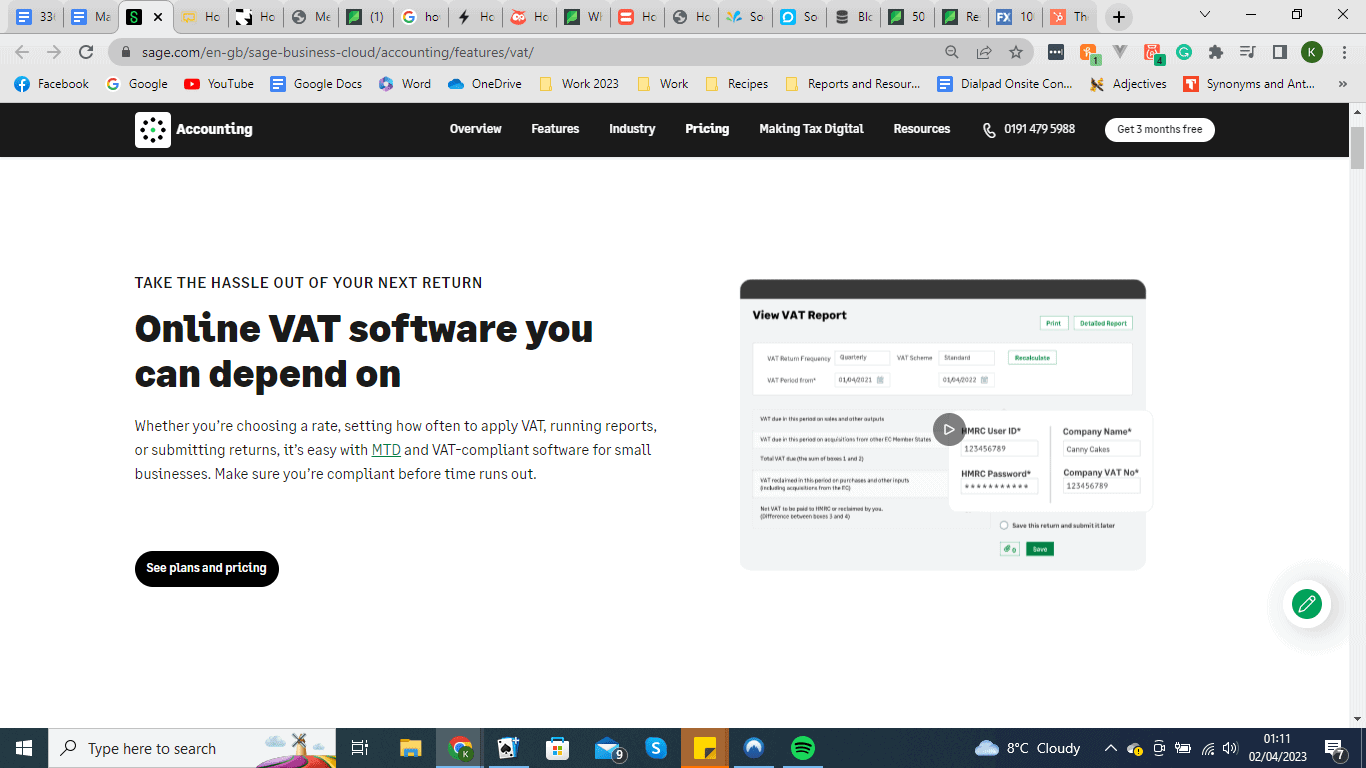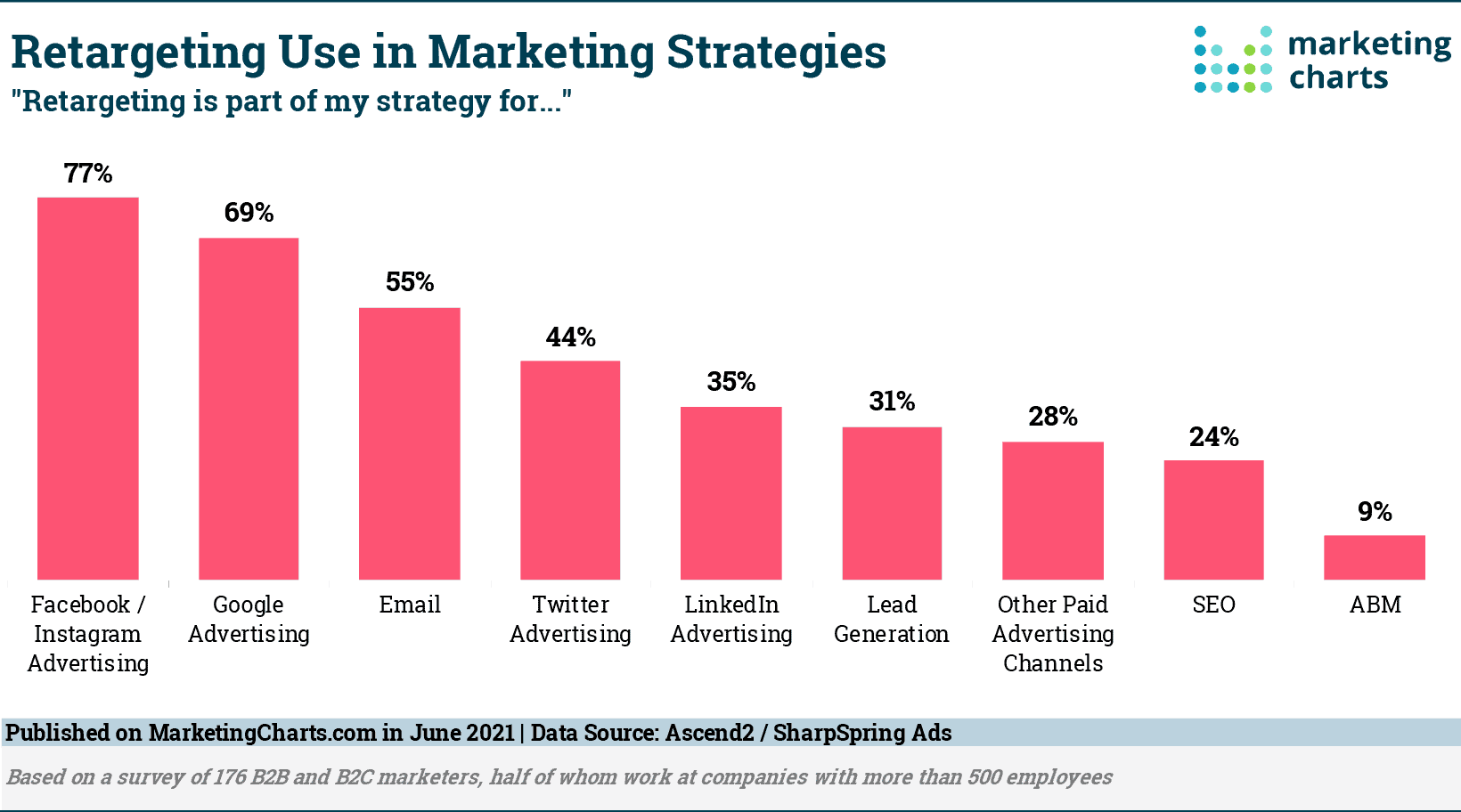If you’re a small-to-medium-sized enterprise doing business in the saturated ecommerce market, knowing how to optimize your social media ad cost should be a top priority.
You’ve probably seen the figures—businesses are spending more on social media advertising than they ever have before. According to recent Statista estimates, businesses are set to collectively shell out over $94bn on social media ads this year, with an annual growth rate of 8.43%.

Image sourced from statista.com
However, blindly throwing money into social media advertising can seriously hurt your bottom line. Strategic social media ad cost management is critical for monitoring the profitability of your ad campaigns and ensuring that your investments are worthwhile.
But where do you start? Let’s explore how you can manage your social media ad budget to cost-effectively generate leads and improve conversions, regardless of how small your wallet might be.
How to set a social media advertising budget
Your social media advertising budget is an integral component of your overall social media marketing budget. But, just like all of your other marketing initiatives, planning your advertising budget should be considered independently using ad-specific market research and data analysis.
Here are the key steps to setting up a reliable social media advertising budget for your SME.
Assess your company’s financial resources
To allocate your financial resources effectively, you need a 360-degree view of the resources that are available to you. Saas funding in India can also provide significant opportunities for bolstering your financial capabilities. Your financial resources are the core funds that will finance your advertising activities. This includes your total business revenue, profits, capital funding, payday loans, credit, liquid assets, and more.
If you already have a marketing budget that finances your other marketing activities (content marketing, email marketing, etc), then you’ll need to consider how increasing your budget or reallocating resources might impact these activities.
Choose your ad platforms and channels
If you think placing ads across every social media channel on the internet is the best way to generate lots of high-value leads, then think again.
To develop a financially-successful social media ad campaign, only invest in the platforms and channels that your target audience frequents.
Why?
Because an advertisement that has little to no audience isn’t going to generate enough clicks, leads, or conversions to make it a profitable investment.
Start by looking at your current traffic sources to identify which social channels generate the most traffic. Then, take a look at your current platforms to see where you receive the most engagement. Your highest performers are where you should focus your attention.
From there, you can delve deeper into channel and competitor analysis to get a better idea of how much you may need to spend on ads within your chosen channel/s. According to recent research, a majority of marketers (25%) recognize Instagram as the channel with the most ROI potential, followed by Facebook and YouTube.

Image sourced from hubspot.com
Determine effective ad types
Some ad types are more expensive—and more effective—than others. When you’re devising your advertising budget, consider the type of ad that you’ll need to use in alignment with the social channel you’re using, the preferences of your target audience, and your overall marketing goals.
Ad types you might use include:
- Static image ads
- Carousel ads
- Short-form video ads
- Dynamic product ads
- Stories ads
- Messenger ads
Your social media ad cost is going to be heavily influenced by the ad types you choose, so be sure to factor this into your budget.
Allocate budget based on data and reports
What’s the secret to determining a cost-effective social media ad budget with a high ROI potential?
Data. As much data as you can get your hands on.
If you have previous financial and marketing reports, you can capitalize on the data they present by using it to make more accurate budget allocation decisions.
For example, your data might detect that while a costly ad format is generating lots of clicks, its low conversion rate lowers its ROI to the point of hurting profitability. Or, you might discover that a low-cost business expense is yielding a high ROI, influencing you to increase your budget in that area.
Speaking of expenses, make sure to keep digital records of taxable business expenses as they offer value to your budgeting process. These will vary depending on whether you’re based in the UK, USA, or elsewhere. So do your research or consult your accountant to make sure you’re fully informed.
Consider using tax accounting software to store expense information and align your budget with your tax bill. Advanced tax software even lets you monitor and analyze real-time cash flow data, meaning that you can stay on top of your social media ad cost relative to your company’s entire financial health.
Managing and optimizing social media ad cost
On average, businesses spend approximately 9.5% of their total revenue on all of their marketing activities. However, while you can use this benchmark to inform your budget, your social media ad cost is likely going to fluctuate as you redistribute, increase, and lower funds in response to the performance of your ad campaigns.

Image sourced from gartner.com
The continuous management and optimization of your ad cost relies on more than tracking ad spend, profit, and revenue. But how do you go about effectively managing and optimizing these costs?
Define KPIs and metrics
Tracking the right KPIs and metrics gives you a quantitative understanding of your ad campaigns’ performance, forming the basis of a robust strategy.
Clearly define and measure the KPIs and metrics that matter most to you. These will differ depending on your social channels and marketing goals, but here are some of the critical ones in the context of social media ad cost optimization.
Cost per lead (CPL): Cost per lead measures how effectively your ad campaign generates leads from a financial perspective. It is calculated by dividing the total cost of the campaign by the number of leads generated. Leads partake in actions that demonstrate an interest in your brand, such as browsing your product pages or following you on social media.
Cost per acquisition (CPA): How effective is your ad campaign at converting leads into customers? CPA measures the aggregate cost of conversion by dividing your total advertising cost by the number of conversions. This is one of the most important metrics to keep an eye on if you’re trying to optimize ad spending to increase ROI.
Return on investment (ROI): Boosting ROI through social media advertising is one of the most common goals for SMEs. ROI determines the overall profitability of your social media ad campaigns. It calculates the money earned from your campaigns compared to the money spent.
Return on ad spend (ROAS): ROAS measures the monetary value of specific ads by calculating the revenue generated from individual campaigns.
There are a bunch of other useful and reliable metrics to help you identify whether your ads are performing well and meeting your business goals. General KPIs include impressions,
click-through rate, conversion rate, and bounce rate.
Consider these metrics in relation to the channel you’re using, as average KPIs can vary significantly. For example, Facebook ads boast consistently high conversion rates of 9.11% across all industries. Other leading channels, like Instagram, have an average conversion rate of only 1-2%.

Image sourced from wordstream.com
Test ad formats to optimize performance
The content preferences of your LinkedIn audience will differ from your Twitter audience. Your TikTok audience might love one format but hate the format that your Instagram audience loves.
Present everyone with the same ad format and you risk hurting your campaign’s performance. Instead, use different testing methods to optimize the performance of your campaigns across channels and for different segments of your target audience.
Despite being the simplest testing method out there, A/B testing delivers considerable value. It involves creating two different versions of the same advertisement and presenting them separately to different groups of your target audience.
From there, you can analyze the performances of each ad and make improvements through a data-driven lens, empowering ads to perform to their full potential.
Implement bidding tactics
Most social platforms manage advertisements through online auctions where you can bid for advertising spaces. Your bidding strategy will determine the maximum amount that you’re willing to spend to achieve a desired action, such as clicks, conversions, or post engagement.
Make sure to implement strategic bidding tactics to help you continuously manage and optimize your ad costs in alignment with your objectives.
Taking Facebook as an example, bidding tactics that you might implement include:
- Lowest cost without bid cap: This default strategy gives Facebook the autonomy to maximize your reach at the lowest cost using your entire budget. A significant flaw in this strategy is that you have no control over your advertising costs.
- Lowest cost with bid cap: Using this bidding strategy, you can set a bid cap to prevent Facebook from exceeding your maximum bid. This gives you more control over your costs and ROI potential. However, it may mean that you miss out on lucrative opportunities or are unable to utilize your entire budget.
- Target cost: Instead of setting a cap, you can set a target cost that Facebook will consider a threshold when making bids. This enables Facebook to bid above and below your target cost while aiming to maintain an average cost per conversion.
Set daily limits to control ad spend
If you don’t set daily bidding limits, your advertising costs will be left at the mercy of social media algorithms. Bid caps ensure that you never spend more than your maximum daily budget, keeping your costs in check throughout the length of your campaigns.
For even more control over your daily ad spend, make sure you’re keeping an eye on tax liability. In the UK, for example, social media advertising is liable to VAT, so this needs to be preemptively factored into your daily budget to avoid the risk of overspending.
This is also an issue in the USA as several states have implemented sales tax on digital advertising and more are set to follow. So it’s important to be aware of this and take it into account when setting your daily limits.
Make sure you’re up-to-date on sales tax laws in your state and make the most of online VAT software if you’re based in the UK or similar tools for US business owners.
They provide a digital paper trail of every tax activity you partake in, which means that you can see the amount of tax you owe at a glance. With a real-time view of your current tax position, you can control your daily ad spend with zero risk.

Image sourced from sage.com
Monitor the ad campaigns regularly
Remember, a high-priced ad that drives lots of engagement but no conversions can hurt your social media ad cost. Avoid this by regularly monitoring your ad campaigns.
After a few days, you should be able to gauge the success of your ads. With the help of a social media analytics tool, analyze the KPIs you defined earlier to assess whether each ad is meeting desired goals.
If your aim is to cost-effectively maximize leads or conversions, for example, look at your cost per lead/cost per conversion KPIs to assess ad performance.
From there, you can work on optimizing your social media ad costs in alignment with objectives. Reallocate funds to your high-performing ads and reduce the budget allowed for underperformers.
Don’t be afraid to scrap low-performing campaigns and use the collected data to redistribute funds more effectively towards current or new campaigns.
Utilize retargeting to find high-quality leads
Retargeting involves using cookies to track prospects across channels and is a powerful strategy for re-engaging high-quality leads.
If you notice that a potential customer recently engaged with your brand but failed to complete a conversion (e.g., to fill in a subscription form or make a purchase), you can target them directly on a social channel with an ad.
Let’s say you notice that a potential customer has abandoned their shopping cart before completing the checkout process. Using retargeting, you can show the customer an ad for the product that they left in their cart via a social media ad.
Retargeting has significant ROI potential as an opportunity to recapture potential leads with personalized ads. Small-to-midsize businesses find it particularly effective, with 80% of SMEs utilizing retargeting across social channels to drive sales, lead generation, brand awareness, and customer retention.
In fact, Facebook and Instagram are the most commonly-used channels for retargeting, surpassing Google and email.

Image sourced from marketingcharts.com
Final thoughts on Social Media Ad Cost
The strategic nature of social media advertising makes continuous monitoring of your ad costs essential to the profitability of your campaigns. From the get-go, you need to consider channel types, ad formats, audience preferences, and other variables that will impact your costs before you’ve even created your first ad.
From there, it’s all about cost-effectively optimizing your social media ad costs in alignment with your business goals. KPI monitoring, bidding strategies, A/B testing, and strict daily spending limits can all help you maximize the performance of your campaigns while keeping costs low and boosting ROI.

